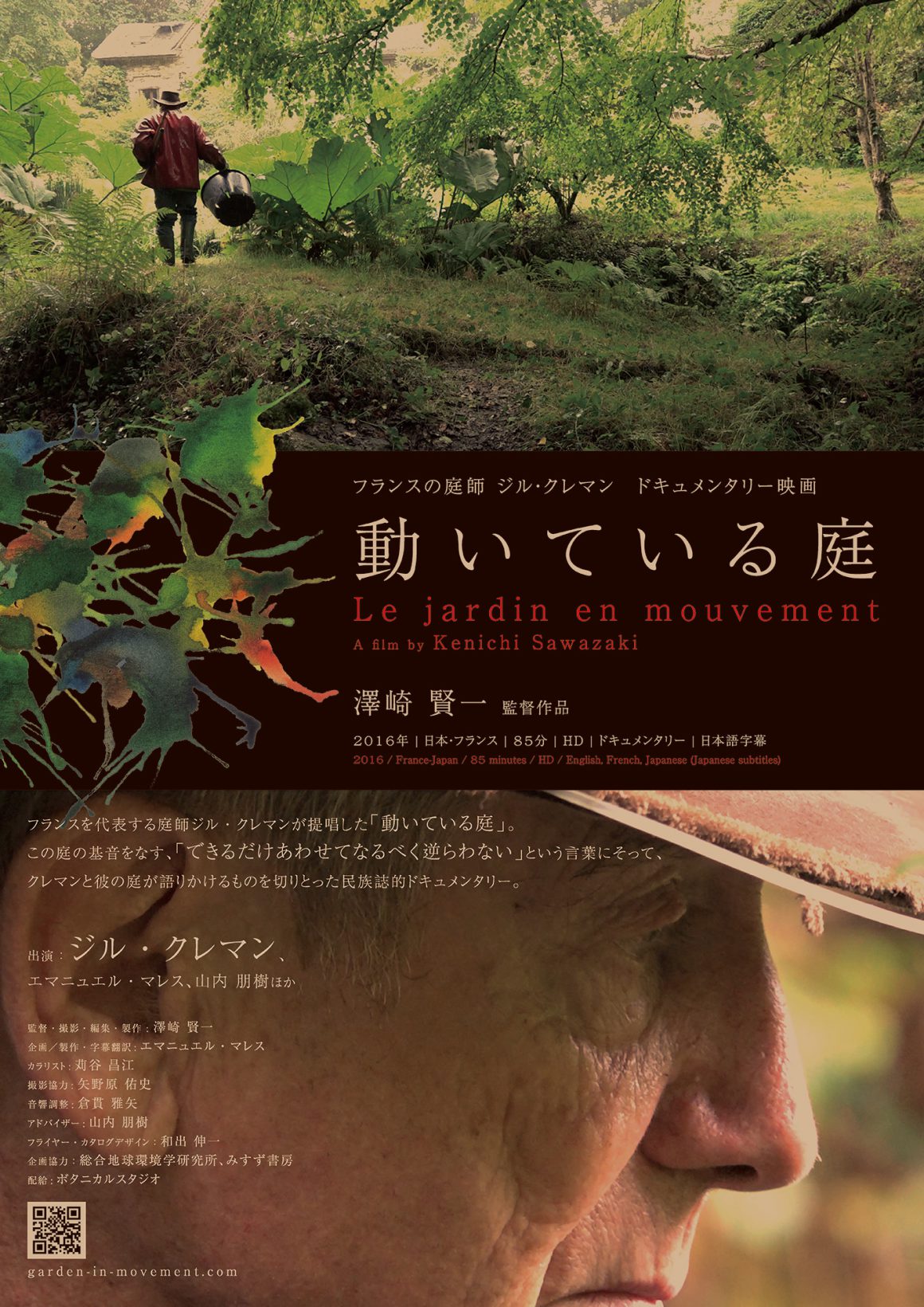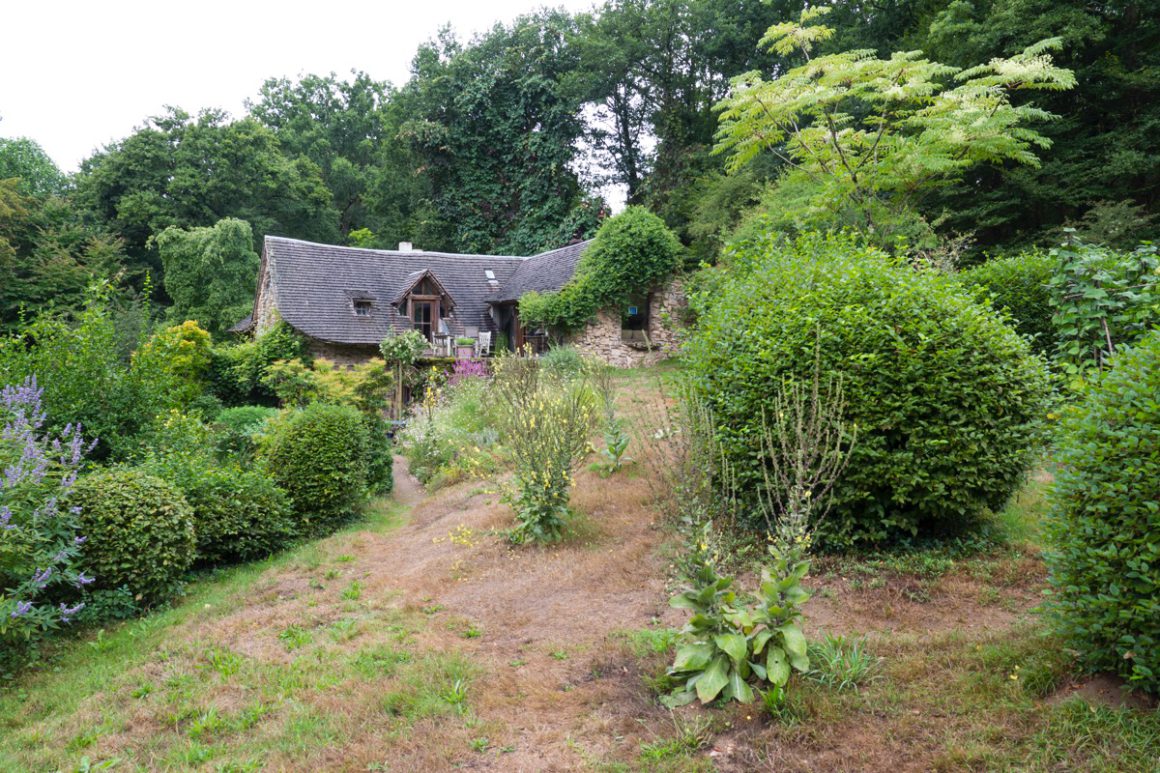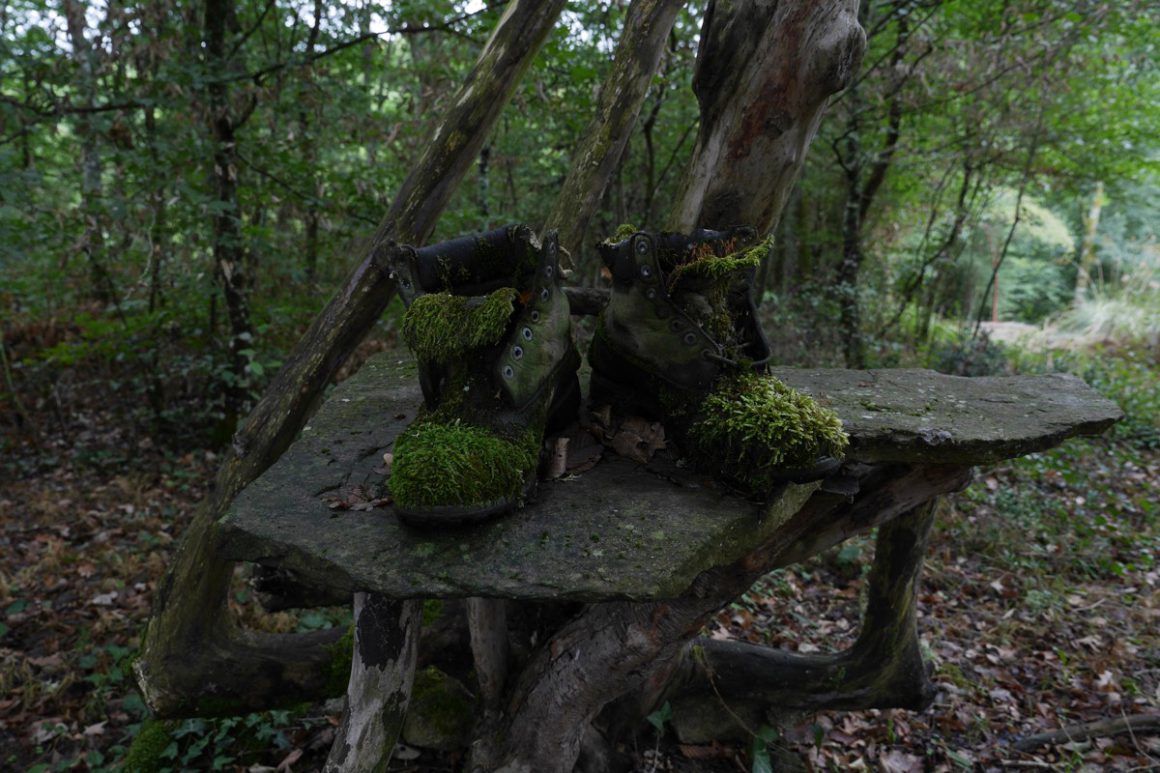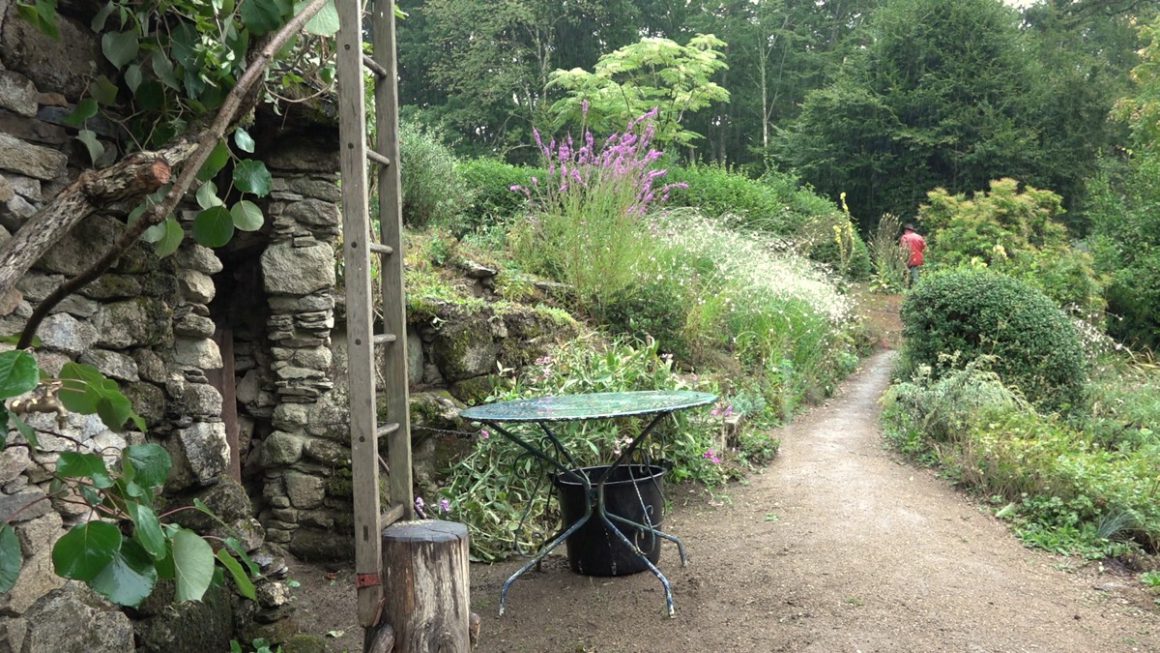
5. できるだけあわせて、なるべく逆らわない
5. To do as much as possible with, as little as possible against
ドキュメンタリー映画『動いている庭』
本章の最後に、フランスの庭師ジル・クレマン(1943-)[1]の活動を記録した映画『動いている庭[2]』(図1-14)の製作について述べる。自然に寄り添い、かたちづくられ、変化し続けるクレマンの庭は、従来の自然と文化を截然と切り離す二分法に基づく思考の再構成を促すものである。この映画は、カメラを片手に被写体に寄り添うように撮られた、いわば「暮らしの目線」からの記録であり、暮らしに垣間みられる資源・生態環境への慎み深い思慮や態度、自然との共生と自己表現の両立可能性、それらを伝えることをねらいとした作品である。
この映画の製作の動機は偶発的なもので、事のはじまりは総合地球環境学研究所(以下、地球研)[3]からのクレマンの日本での活動記録映像の製作依頼であった。クレマンは、地球研が主催した連続講演会のために2015年に初めて日本を訪れた。連続講演会の内容は、それぞれ「Ⅰ. 都市のビオロジー」・「Ⅱ. 地球という庭」・「Ⅲ. 庭のかたちが生まれるとき」と題された[4]。このとき製作された記録映像『ジル・クレマン連続講演会[5]』では、この3つの連続講演会の様子や日本各地をクレマンが庭師や庭園研究者たちと視察する様子が紹介された。この記録映像の製作をきっかけにして、僕はただ一人でフランスにあるクレマンの自宅の庭を訪れ、そこで撮影した映像を中心に編まれたのが、映画『動いている庭』である。この映画を概観するために、映画のイントロダクションを以下に引用しておく。
この惑星は、庭とみなすことができる― パリで行われた展覧会「惑星という庭」で30万人を魅了したフランスの庭師ジル・クレマン。彼は、パリのアンドレ・シトロエン公園の庭やケ・ブランリー美術館の庭をつくったことで知られ、同時に、その背景にある思想が注目を浴びてきた。
クレマンは、地球研が主催した連続講演会のために、2015年の冬に初めて日本を訪れた。計3回開催された講演会は、それぞれ彼の中心的な概念である「動いている庭」「惑星という庭」「第三風景」をめぐるものである。
たとえば、「動いている庭」。そこでは、草や木が自然の遷移の作用として移動し、その移動のダイナミズムの中で庭が構成されていく。それは自然なのか、文化なのか? 自然に寄り添い、かたちづくられ、変化し続ける庭は、従来の自然と文化を截然と切り離す二分法に基づく思考の再構成を促すものである。
日本各地を視察するクレマンの中心となる案内人は、彼の著作『動いている庭』を翻訳した庭師の山内朋樹と日本庭園を研究するエマニュエル・マレスである。このふたりと共に、クレマンは日本の庭を訪れ、日本の庭師と交流を深める。果たして、彼は日本の自然や文化に何を見出すことになるだろうか。
「動いている庭」、クレマンの自宅の庭には、その原型がある。クルーズ川に面した広大な庭の中を歩きながら、彼は「谷の庭」や「野原」と名付けられた場所を案内する。多様性に富んだ庭もさることながら、自ら建てた家に太陽光発電を設置し無駄に電気を使用しないことや、自宅の畑で採れた野菜で食事をすることなど、彼の生き方から私たちが学ぶことは多いだろう。すべては、この場所から始まったのである。
できるだけあわせて、なるべく逆らわない― これは、クレマンの庭師としての基本的な態度である。この言葉にそってつくられた本作は、日本各地を訪問するクレマンと、彼の自宅の庭をロングショットで記録した民族誌的な映像である。クレマンの行為を長回しで撮影する中で、撮影者がカメラになり、そしてそれを通して撮影者は被写体と呼吸リズムを同調させる、呼応するようにクレマンも何か新しい輝きを持った存在になるだろう[6]。
Documentary film The Garden in Movement
Finally, I discuss the production of the film The Garden in Movement[2] (Figures 1-14), which documents the activities of the French gardener Gilles Clément (1943-)[1]. Clément’s garden, which is shaped, shaped and changing alongside nature, encourages a reconfiguration of thinking based on the traditional dichotomy that separates nature and culture. The film is a record from the perspective of the people who live in the garden, filmed with a camera in hand as if they were close to the subjects, and aims to convey the modest consideration and attitude towards resources and the ecological environment that can be glimpsed in their daily lives, and the compatibility of self-expression and symbiosis with nature.
The motivation for the film’s production was accidental, beginning with a request from the Research Institute for Humanity and Nature (RIHN)[3] to produce a documentary film of Clément’s activities in Japan. Clément first visited Japan in 2015 for a series of lectures organised by the RIHN. The lectures in the series were respectively entitled ‘I. La biologie urbaine’ and ‘II. La terre comme un jardin’ and ‘III. Quand le jardin prend forme”[4]. The documentary film Gilles Clément, un jardinier français au Japon[5] produced at this time showed these three lecture series and Clément’s visits with gardeners and garden researchers around Japan. The production of this documentary film led me to visit Clément’s home garden in France alone, and the film The Garden in Movement was woven around the footage I shot there. To give an overview of the film, the introduction to the film is quoted below.
“This planet can be thought of as a garden.” This was the key concept of Planetary Garden, an exhibition in Paris by the French gardener Gilles Clément that captivated 300,000 visitors. Known for being the creator of the André Citroën Park and Quai Branly Museum Garden, the philosophy that informs his creations are also in the spotlight.
Clément visited Japan for the first time in the winter of 2015 for a lecture series at the Research Institute for Humanity and Nature. This series was split into three parts, each of which focused on his three central concepts: The Garden in Movement, The Planetary Garden and The Third Landscape.
For example, looking at The Garden in Movement, grass and trees are caused to move with the transformations of nature, bringing about the formation of a garden through the dynamism of change. Is this nature or culture? Considered as something attached closely to nature, as shaped, as continuously changing, the garden encourages us to reconsider the conventional, bisectional distinction that separates nature and culture.
In his exploration of Japan, Clément is guided by Tomoki Yamauchi, who translated his book The Garden in Movement into Japanese, and Emmanuel Marès, a researcher in history of Japanese gardens. With Tomoki and Emmanuel, Clément visits Japan’s gardens and deepens his relations with Japan’s gardeners. What will he find in Japanese nature and culture?
The origins of The Garden in Movement can be found in Clément’s own garden. Walking through an expansive garden facing the Creuse River, Clément shows us to places he has labeled ‘Valley Garden’ or ‘The Meadow.’ While it is of course a richly varied garden, we can also learn much from how he lives his life; solar panels on his self-built house to save energy, meals of vegetables harvested from his own field. Everything has started from this place.
To do as much as possible with, as little as possible against. this is Clément’s fundamental approach as a gardener. Respecting this creed, this ethnographic film records Clément in long shot as he tours Japan and shows us his own garden. Recording Clément’s behavior in a long take, the cinematographer becomes the camera and through this synchronizes breath with the camera’s object, prompting Clément’s being to come in possession of a new, shining brilliance[6].




この映画で僕は、クレマンの庭師としての基本的な態度をそのまま踏襲するようなかたちで、「できるだけあわせて、なるべく逆らわない」ように、クレマンの仕草や語りを丁寧に映像で記録しようと試みた。この映画は、クレマンの活動を概観するものではなく、また取り立てて物語が見いだせるものでもなかった。
このような映画として制作した理由は、最初期の僕の作品制作での問いと関係していた。2008年の作品《日常としての表象》で試みたように、「作家の主体性」を剥き出しの状態で提示するためにアガンベンの「動物化」をその作品制作の理論的な下敷きにして、「作家」という生き物の生活サイクルを見せようとしていた僕にとって、クレマンの「できるだけあわせて、なるべく逆らわない」という積極的に主体的であるわけでもなく、かつ全く関わりがないわけでもない、その「あいだ」にある姿勢は、別のやり方で「作家の主体性」を消極的だがとてもポジティブなかたちで宙吊りにしているように思われたからである。作者の意図によって構成され、作品の見方が限定されるような手法ではなく、できるだけジル・クレマンという主題の細部にまなざしを向けたかった。
もう1つ現実的な問題としては、庭園研究が専門ではなく、また植物の生態にも明るくない僕は、最初クレマンの視線の先に何があるのかが分からなかった。だからこそ、僕はクレマンに寄り添い、撮影しながら彼が見ている世界を少しずつ学んでいく必要があった。このとき、「できるだけあわせて、なるべく逆らわない」という姿勢と共に映像メディアを活用することが、自分自身が身につけてきたものとは領域の異なる世界についての学びの機会を開いてくれるように感じられた。
—
[1] ジル・クレマンは庭師、修景家、小説家など、数多くの肩書きを持つ。植物にとどまらず生物についての造詣も深く、カメルーン北部で蛾の新種を発見している。庭に植物の動きをとり入れ、その変化と多様性を重視する手法はきわめて特異なもの。代表的な庭、公園に、アンドレ・シトロエン公園(パリ、1986-98年)、アンリ・マティス公園(リール、1990-95年)、レイヨルの園(レイヨル=カナデル=シュル=メール、1989-1994年)、ケ・ブランリ美術館の庭(パリ、2005年)などがある。おもな著作として、庭園論に『動いている庭』(1991年)、『惑星という庭』(1999年)、『第三風景宣言』(2004年)。小説に『トマと旅人』(1997年)ほか。
[2] 映画『動いている庭』(監督:澤崎賢一, フルHD, 85分, 2016年)は、「第8回恵比寿映像祭」(恵比寿ガーデンシネマ, 2016年)にてプレミア上映され、その後も立誠シネマ(京都, 2017年)や第七藝術劇場(大阪、2017年)や神戸アートビレッジセンター(神戸, 2018年)、池袋シネマ・ロサ(東京, 2018年)など国内外で劇場公開された。
公式ウェブサイト:http://garden-in-movement.com/
[3] 総合地球環境学研究所は、大学共同利用機関の研究機関として2001年に創設された。地球研では、地球環境問題を「人間(Humanity)」と「自然系(Nature)」の相互作用の問題としてとらえている。地域的な特性や歴史的な経緯などを考慮しつつ、この相互作用のあり方を解明しようとしている。また、さまざまな形で現れてくる地球環境問題を総合的に研究し、未来可能性のある社会の構築をめざしている。https://www.chikyu.ac.jp/about/, 2021年1月4日アクセス
[4] 連続講演会の概要を地球研のウェブサイトで見ることができる。
http://www.chikyu.ac.jp/publicity/events/etc/2015/0221_23_27.html
[5] 記録映像『ジル・クレマン連続講演会』(フルHD, 26分, 2015年)。総合地球環境学研究所製作。撮影/編集は澤崎が担当した。本作は、総合地球環境学研究所のYouTubeで見ることができる。https://youtu.be/37uL6zQwrL4
In this film, I tried to document Clément’s gestures and narratives carefully on film in a way that followed his basic attitude as a gardener, ‘To do as much as possible with, as little as possible against’. The film was not intended to be an overview of Clément’s activities, nor did it provide any particular narrative.
The reason for making the film as such was related to a question I had asked myself in the early stages of my filmmaking: as I tried to do in my 2008 film a symbol as a daily life, I used Agamben’s “animalisation” as the theoretical basis for my filmmaking in order to present “the subjectivity of the artist” in its bare form. For me, who was trying to show the life cycle of the “artist”, Clément’s “To do as much as possible with, as little as possible against”, which is neither actively proactive nor totally uninvolved, is an attitude that lies “in between” the two. I was also interested in the ‘in-between’ attitude, because it seemed to me that in another way it suspended the ‘subjectivity of the author’ in a negative but very positive way. I wanted to focus my gaze as much as possible on the details of the subject Gilles Clément, rather than on a method that is structured by the artist’s intentions and limits the view of the work.
Another practical problem was that, not being a specialist in garden research or knowledgeable about plant ecology, I was initially unsure of what was beyond Clément’s gaze. That is why I had to learn about the world he was looking at little by little while I was close to him and photographing him. At this point, I felt that the use of visual media, together with the attitude ‘to do as much as possible with, as little as possible against’, seemed to open up opportunities to learn about a world that was different from the one I had acquired myself.
—
[1] Born in 1943. Gardener, landscape designer, botanist, writer… Gilles Clément is a man of many faces. Connoisseur of plants, animals and all the living being in general, he discovered a new species of butterfly in Cameroun (Bunaeopsis clementi). His way of thinking the garden, respecting the biodiversity and the mouvement of plants is totally new and unique. His main works: André Citroën Park in Paris (1986-94), Henri Matisse Park in Lille (1990-95), Domaine du Rayol in Rayol-Canadel-sur-Mer (1989-1994), The Garden of the Musée du Quai Branly (2005), etc. His main books: Le jardin en mouvement (1991), Le jardin planétaire (1999), Manifeste du tiers-paysage (2004), Thomas et le Voyageur (1997), etc.
[2] The film The Garden in Movement (Director: Kenichi Sawasaki, Full HD, 85 min, 2016) premiered at the 8th edition of the Yebisu International Festival for Art & Alternative Visions (Yebisu Garden Cinema, 2016). The film was subsequently released in theatres in Japan and abroad, including Rissei Cinema (Kyoto, 2017), The Seventh Art Theater (Osaka, 2017), Kobe Art Village Centre (Kobe, 2018) and Cinema ROSA (Tokyo, 2018).
Official website: http://garden-in-movement.com/index_eng.html
[3] The Research Institute for Humanity and Nature (RIHN) was founded in 2001 as a research institute of the Inter-University Research Institute Corporation. The RIHN views global environmental issues as problems of interaction between Humanity and Nature. It seeks to elucidate the nature of this interaction, taking into account regional characteristics and historical background. It also aims to comprehensively study global environmental problems that emerge in various forms, with the aim of building a society with future potential.
https://www.chikyu.ac.jp/rihn_e/about.html, accessed 4 Jan 2021
[4] An overview of the ‘un jardinier français au Japon’ in French can be found on the RIHN website.
https://www.chikyu.ac.jp/publicity/events/etc/2015/0221_23_27_f.html
[5] Documentary film Gilles Clément, un jardinier français au Japon (Full HD, 26 min, 2015), produced by RIHN. Filming/editing by Sawasaki. The film can be viewed on RIHN’s YouTube. https://youtu.be/37uL6zQwrL4